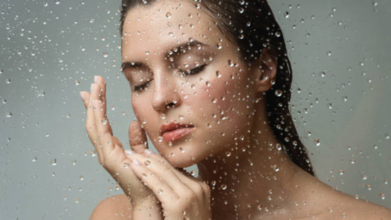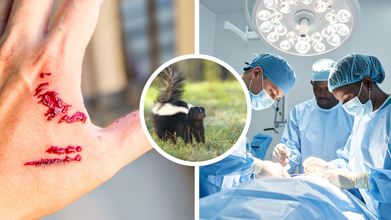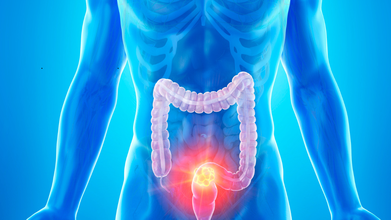- Health Conditions A-Z
- Health & Wellness
- Nutrition
- Fitness
- Health News
- Ayurveda
- Videos
- Medicine A-Z
- Parenting
7 Monsoon Skincare Habits To Keep Your Skin Clear And Healthy, According To A Dermatologist

Credits: iStock
The monsoon is a time of relief, romance, and revival but your skin may be anything but refreshed. When raindrops fall and humidity surges, skin may prove to be an unwelcome adversary. Breakouts, rashes, fungal infections, and dullness are usual grievances dermatologists hear in the rainy season. Unlike the hot, sun-baked days of summer, the monsoon offers a special combination of moisture, heat, and microbial activity that can disturb the skin's natural balance.
Moreover, the mix of sweat, soggy clothes, and environmental toxins is a recipe for congested pores and inflammation. So how do you indulge in the seasonal transformation without ruining the cost of skin well-being? We consulted Dr. Neha Virmani, MD, DNB (Dermatology), Founder of Inara Skin, Hair and Aesthetics, Mumbai, to demystify seven evidence-based skincare tips to have balanced, hydrated, and infection-free skin during monsoons.
Why Skin Behaves Differently in the Rainy Season?
Monsoon climate shows skin a seeming paradox. The skin may be soft and dewy due to excess humidity, but this moisture outside may be hiding internal dehydration and barrier compromise. According to Dr. Virmani, "Humidity makes sebum production increase, which, when mixed with sweat and pollution, clogs pores and aggravates acne. Most patients experience flare-ups at this time."
Rain indirectly aggravates acne by providing a breeding ground for bacterial and fungal pathogens on the skin surface. The combination of excess sebum, dampness, and friction from wet clothes can cause sudden breakouts, rashes, and infections if day-to-day hygiene is not adjusted according to season. Knowing these seasonal imperatives is the beginning of tailoring a monsoon-friendly skincare regimen.
Can Rain Trigger Acne?
The rainy season, when there is a surge in humidity, causes your skin to retain more sweat, oil, and toxins. This provides a tacky, damp coating on the surface of your skin that clogs pores and feeds bacteria—prime promoters for acne attacks. Wet clothing, prolonged wet hair, and moisture from wet fabrics add to the problem, particularly on the back, chest, and shoulders.
Also, changing weather can break down the skin barrier, causing inflammation and excess sebum. Even mild fungal infections can reproduce or exaggerate acne-like bumps.
So, though the rain itself isn't actually responsible for pimples, it creates conditions on your skin that can certainly cause more breakouts.
Here are seven dermatologist-approved, evidence-based skincare tips to keep your skin clean, healthy, and calm during the rainy months.
1. Cleanse Twice a Day
Your skin tends to acquire sweat, oil, and atmosphere dirt faster during the monsoon. Dr. Virmani recommends, "Washing twice daily removes residue without depriving the skin's natural shield. Over-washing can cause rebound oiliness and redness."
For oily or acne skin, she suggests light foaming cleansers with salicylic acid to exfoliate pores, along with niacinamide to combat inflammation. The objective is a balanced regimen that leaves skin clean, calm, and prepared to take in moisture and treatments.
2. Don't Skip the Moisturizer
Even with humid conditions, air during the monsoons can subtly dehydrate. "Most people think the skin is naturally hydrated since it feels wet," Dr. Virmani points out. "But trans-epidermal water loss can still happen, breaking down the skin barrier."
Choose water-based, gel-based, or light moisturizers with hyaluronic acid or glycerin. Select non-comedogenic, oil-free products for acne skin to ensure moisturization without pore clogging. Regular moisturizing helps in repairing skin, controlling oil secretion, and keeping the complexion hydrated.
3. Don't Let the Clouds Fool You
Cloudy skies do not eliminate UV exposure. Dermatologists emphasize year-round protection. Dr. Virmani says, “Even on overcast days, UV rays penetrate clouds and can cause pigmentation, premature aging, and uneven skin tone. Gel-based or matte-finish sunscreens with SPF 30 or higher are ideal for monsoon comfort.”
Reapplication every three to four hours is crucial, especially if you’re outdoors or sitting near windows. Sunscreen protects the skin from long-term damage, making it as vital as hydration or cleansing.
4. Be Proactive Against Fungal Infections
Rainy weather encourages fungal growth in hot, moist conditions. "Places such as underarms, inner thighs, and between toes are especially susceptible," Dr. Virmani outlines. "Preventive hygiene—proper drying following bathing, airy clothing, and footwear rotation—can cut down on infections dramatically."
Dermatologists can recommend anti-fungal powders or medicated shampoos for recurrent flare-ups. Foregoing it during the early stages is much simpler than battling chronic infection later in the season.
5. Be Mindful of Deeper Hydration
Sweat appearing on the skin may not be enough in monsoon-induced skin stress. For deeper hydration, injectable skin boosters like Profhilo can rehydrate under the surface, triggering collagen and elastin. Dr. Virmani states, "Treatments like Profhilo enhance skin quality from the inside out, restoring firmness and glow to those experiencing seasonal dullness."
Such bioremodelling treatments are especially effective for mature skin or anyone seeing loss of tone and vitality during rainy weather.
6. Revamp Your Makeup Routine
Heavy makeup clogs pores and ensnares oil and sweat, causing them to break out. Dr. Virmani recommends, "Swap full-coverage foundations for tinted moisturizers, primers, or BB creams. Keep your routine efficient and sparse, prioritizing SPF and multi-tasking products."
Evening cleansing is essential to take out sweat, makeup, and impurities. Healthy skin is the foundation of any successful makeup regimen, so skincare needs to precede it.
7. It's More Than a Clean Face
Monsoon hygiene is more than just a washed face. "Bacteria and fungi survive not only on skin but on towels, pillowcases, and makeup brushes too," says Dr. Virmani. Regular washing of textiles and cleaning of brushes minimizes infection potential and avoids sudden outbreaks.
Don't share towels, dry makeup tools, and change pillowcases every 2–3 days. Easy hygiene improvements can make a big impact in keeping skin healthy.
Monsoon skincare doesn't have to be complicated. As per Dr. Virmani, "Consistency, awareness, and the right care make all the difference." By properly cleansing, moisturizing, safeguarding against UV damage, and being watchful for fungal and bacterial threats, your skin can stay calm, balanced, and radiant during the rainy months.
Diagnostic Anomaly: In An 'Exceptionally Rare' Case, Man Dies Of Rabies After Kidney Transplant

Credits: Canva
In a what doctors call an "exceptionally rare event', a Michigan man has died of rabies after receiving a kidney from a donor who was unknowingly infected with the virus. A recent report from the Centers for Disease Control and Prevention (CDC) gives information on how this rare medical event took place, with a surprising chain of exposures that vegan with a skunk scratch.
A Routine Kidney Transplant That Took a Sudden Turn
The Michigan patient underwent a kidney transplant at an Ohio hospital in December 2024. For several weeks, he seemed to be recovering normally. About five weeks after the procedure, he suddenly developed worrying symptoms such as tremors, weakness in his lower limbs, confusion and urinary incontinence. His condition deteriorated quickly and he was admitted to the hospital, soon requiring ventilation. Despite treatment, he passed away. Postmortem tests confirmed that he had rabies, a diagnosis that shocked doctors since his family said he had not been around any animals.
The Donor’s Skunk Encounter Comes to Light
The unexpected diagnosis pushed doctors to take another look at the kidney donor, a man from Idaho. In the Donor Risk Assessment Interview, he had mentioned that a skunk had scratched him. At the time, this detail did not raise major concern. When investigators spoke to the donor’s family again, they learned more about the incident. A couple of months before his death, the donor had been holding a kitten in a shed on his rural property when a skunk approached and behaved aggressively. He stepped in to protect the kitten and managed to knock the skunk unconscious. Before that happened, the animal scratched his shin deeply enough to draw blood. He believed he had not been bitten, and the incident was never viewed as a medical emergency.
The Donor’s Rapid Decline
Around five weeks after the skunk encounter, the donor began showing symptoms that closely resemble rabies. He became confused and had trouble swallowing and walking. His family said he experienced hallucinations and complained of a stiff neck. Two days later, he was found unresponsive at home after what was believed to be a cardiac arrest. He was resuscitated and hospitalized but never regained consciousness. He was declared brain dead after several days, and his organs, including his left kidney, were donated.
What Investigators Found
Once rabies was detected in the kidney recipient, authorities examined stored laboratory samples from the donor. These tests were initially negative. However, kidney biopsy samples revealed a strain that matched silver-haired bat rabies. This finding suggested that the donor had in fact died of rabies and unknowingly passed the virus to the transplant recipient.
Investigators believe a likely three step transmission occurred. A bat infected a skunk, the skunk infected the donor, and the donor’s kidney infected the recipient. The CDC noted that only three other cases of rabies transmission through organ transplantation have been reported in the United States since 1978.
Steps Taken to Protect Other Recipients
Three other people had received cornea grafts from the same donor. Once the risk was identified, the grafts were removed and all three individuals received Post Exposure Prophylaxis. They remained healthy and showed no symptoms.
A Reminder of Rare but Real Risks
Rabies is not routinely tested for in organ donors because human cases are extremely rare and difficult to diagnose. In this situation, the donor’s earlier symptoms were attributed to existing health conditions. Speaking to the New York Times, Dr Lara Danziger-Isakov said the case was exceptionally rare and reminded the public that the overall risk to transplant recipients remains very small.
China Reversed Its Air Pollution Problems; What Lessons Can Delhi Learn?

Credits: Canva
Delhi continues to wake up to thick haze on Wednesday morning, with 28 stations in 'poor' category, while nine stations remained under 'very poor'. Though there is a slight improvement as the average AQI stood at 269, in poor category. The Chief Minister of Delhi has enforced stricter measures like imposing fines up to Rs. 5,000 for open burning, and use of coal and firewood.
Delhi pollution has now affected people way beyond their respiratory health, it has now attacked almost all organs of their body, including fetus, reproductive health, liver, kidneys, and even chronic diseases like diabetes, obesity, blood pressure, and even mental health illness.
But could Delhi do more? Right now all the measures, including emergency measures like GRAP have not worked more than a dent. However, China seems to have reverse its pollution problem.
What Did China Do That Delhi Too Can Adopt?
In 2013, Beijing was battling with pollution problem. As per the data by the World Health Organization (WHO), in 2013, the annual means of PM2.5 levels reached 64.9 micrograms per cubic meter, whereas, in India, it was at 58.2. However, by 2019, China was able to bring it down to 38.15 micrograms per cubic meter while India remained at 50.17.
So, what did China do?
Since 2013, almost 80% of China has experienced air quality improvement. Beijing declared a war on pollution by shutting 3,000 coal boilers, which slashed coal use by 30%. It also forced factory to either close or comply with the guidelines. Clean energy also replaced soot and electric buses replaced diesel ones. The subway was expanded to 1,000 kilometers and by 2020, 40% of new cars were electric.
Chin's 11th Five Year Plan That Made Pollution A Priority
In the late 2000s, China began taking air pollution more seriously than ever. As per the UCLA Law professor Alex L Wang, China's 11th FYP (2006-10) made pollution a priority and used the "cadre evaluation system". This pushed officials to meet environmental targets. The system evaluates governors, mayors, and local leaders based on how well they perform compared to others in tackling pollution problem, which influences their promotions.
To cut pollution, China invested heavily in cleaner technology and shut down old, highly polluting factories such as power plants, smelters, and chemical units. The government also encouraged the shift to electric vehicles. Even though much of China’s electricity comes from coal, EVs still produce fewer emissions overall and create no tailpipe pollution in cities.
By 2017, Shenzhen became the first city in the world to fully electrify its 16,000 buses. Shanghai too followed its lead.
Studies by Tsinghua University and the Beijing Environmental Bureau showed that between 2013 and 2017, major improvements in air quality came from reducing coal boiler use, cleaner home heating, shutting down polluting industries, and controlling vehicle emissions.
The result was nothing less than remarkable. From 2013 to 2017, Beijing’s PM2.5 levels dropped by 35%, and life expectancy rose by 4.6 years.
What Men Should Know About Their Prostrate Health After 50, According To Doctor

Credits: Canva
As men step into their 50s and beyond, prostate health becomes an essential part of overall wellbeing. The gland naturally undergoes changes with age, many of which are not cancerous but can still cause discomfort, disrupt daily routines, and affect long-term health. Awareness, early screening, and preventive habits play a crucial role in staying ahead of potential problems.
Why the Prostate Changes With Age
One of the most common age-related concerns is benign prostate hyperplasia (BPH), a non-cancerous enlargement of the prostate. This happens due to hormonal shifts that cause the gland to grow slowly over time.
“Most men assume urinary symptoms are just a normal part of aging, but that mindset often delays treatment,” says Dr. Vineet Malhotra, Director and Founder, VNA Hospital. “BPH itself is not dangerous, but if ignored, it can seriously affect quality of life and even lead to complications.”
A larger prostate can press against the urethra, causing symptoms such as:
- Frequent urination
- Weak or interrupted urine flow
- Difficulty starting to urinate
- A feeling of incomplete bladder emptying
- Waking up multiple times at night to urinate
These symptoms often creep up gradually, making them easy to dismiss until they start interfering with sleep, work, or general comfort.
The Importance of Screening for Prostate Cancer
While BPH is not cancer, men must remain vigilant about prostate cancer, especially because its risk rises with age.
“Prostate cancer in early stages is usually silent,” explains Dr. Malhotra. “That is exactly why screening becomes so important once men cross 50.”
Two common screening tools include:
- PSA (Prostate-Specific Antigen) test
- Digital Rectal Examination (DRE)
These tests help detect abnormalities long before symptoms appear. Early detection not only improves treatment outcomes but also prevents unnecessary anxiety or uncertainty.
Men should also stay alert for red-flag symptoms, including persistent pelvic pain, unexplained weight loss, blood in urine or semen, and sudden urinary changes.
Lifestyle Choices That Support Prostate Health
Beyond medical screening, everyday habits have a strong influence on prostate wellbeing.
Dr. Malhotra emphasizes the role of lifestyle:
“A balanced diet, regular exercise, and maintaining a healthy weight can significantly reduce inflammation and support better prostate function.”
Healthy habits that help include:
- A diet rich in antioxidants (tomatoes, berries, leafy greens)
- Omega-3 sources like fatty fish and walnuts
- Limiting alcohol and caffeine
- Staying well-hydrated
- Avoiding smoking
- Regular physical activity
These choices not only support the prostate but also improve urinary health and hormonal balance.
Since stress can worsen urinary symptoms, incorporating yoga, meditation, or deep-breathing practices also makes a noticeable difference.
Breaking the Silence Around Prostate Health
One of the biggest challenges is the reluctance many men feel when discussing urinary or sexual symptoms.
“Men often suffer quietly because these issues feel too personal,” says Dr. Malhotra. “But silence delays diagnosis and treatment. Open conversations can literally save lives.”
Families, caregivers, and partners can play a supportive role by encouraging early checkups and normalizing discussions around prostate health.
The Bottom Line: Proactive Care Matters
With rising life expectancy and a more active older population, prioritizing prostate health is no longer optional—it’s essential.
Early diagnosis, informed decision-making, and evidence-backed treatments give men the chance to maintain independence, comfort, and quality of life well into their later years.
As Dr. Malhotra puts it, “Prostate health is not just a medical concern—it’s a foundation for staying energetic, confident, and healthy as you age.”
© 2024 Bennett, Coleman & Company Limited

